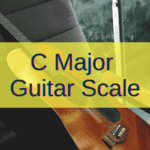Everybody you know that plays guitar, even your biggest guitar hero started the same way.
Yes, we all struggle to connect our brains to our fingers and make them do what we want instead of obeying their will.
The good news is that after conquering that first milestone, you can start playing your favorite songs and that’s when the real fun starts.
In this post, you’ll find 15 guitar chords that can be the golden key to unlocking the door to a fruitful, fun, and successful career as a guitarist.
If that’s not your goal, you can use them for bonfire sing-alongs, karaoke nights, and impromptu jam sessions anywhere.
Welcome to your first big step toward guitar mastery, one chord at a time.
Open Chords
Perhaps, you’ve heard this term before.
Open chords have the characteristic of utilizing at least one open string.
This quality makes them sound huge and full.
If you’re an Oasis fan, you’ll know that many of Noel’s compositions are based on this kind of chords; they’re the perfect grandiloquent statement for Liam’s voice.
But ‘90s legends aside, open chords are the first ones you should learn because they are the ones that require the least effort to sound properly.
That being said, they do require a learning curve, especially when you’re jumping from one to the next.
So, address the chord diagrams you’ll find next with patience and let your fingers work out the rest. Believe me; you’ll be playing your favorite tunes in no time.
Let’s Talk About Major Chords
Major chords are made with three notes; that’s why we also call them triads.
This triad is made by using the 1st, 3rd, and 5th notes of a major scale. So, for example, if we take the C major scale, the quintessential C major chord is: C – E – G.
This is the easiest because there are no accidents in the C major scale (accidents are flats and sharps). But what happens if we want to put together a D major chord?
Well, we do the same thing; we pour the D major scale over the 1 – 3 – 5 structure. So, the D major chord is D – F# – A.
If we continue to pour each scale inside the same formula, we’ll get all the major chords.
Let’s take a look at the ones that can be played as open chords:
C: C – E – G
D: D – F# – A
E: E – G# – B
G: G – B – D
A: A – C# – E





What about F and B? Well, these are two special cases because they aren’t open chords.
This means you can’t play them utilizing open strings; you have to fret every note.
I’m adding two simplified shapes so you can fake-it-till-you-make-it.
Of course, once you learn how to play bar chords, you can use a different version of them.
F: F – A – C
B: B – D# – F#


Before we move on to minor chords, it’s important to say that major chords sound full, round, and happy. They are very common in strong statements like choruses and happy songs.
Finally, they’re also a great way to resolve the tension in a chord progression.
We’ll see more about that in a bit.
Let’s Talk About Minor Chords
Minor chords are also triads, but the difference between them and major chords is that instead of being the first, third, and fifth degree of a major scale, minor chords utilize a flat third.
This means that the third should move back by one fret or semitone.
So, if D major is D – F# – A, then D minor will be D – F – A because we’re lowering the third half a tone. The same thing happens with A major (A – C# – E).
If we move the C# to a C we can make it A minor (A – C – E).
Let’s take a look at some of the most used minor chords in popular music.
Dm: D – F – A
Am: A – C – E
Em: E – G – B
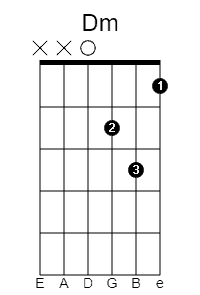

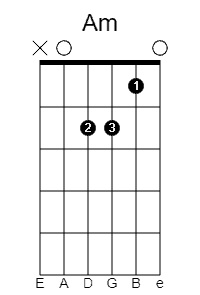
Hey, but what about Fm and Bm?
Well, since the difference between F and B major and the same chords in their minor iteration is a flat third, I’m going to give you alternative ways of playing them until you master bar chords.
Bm: B – D – F#
Fm: F – G# – C
This is what these alternative forms look like:

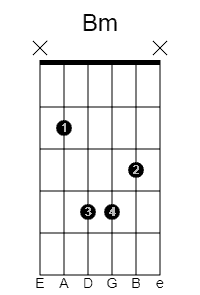
While major chords sound round, full, and happy, minor chords occupy a very different sonic space.
Yes, they are the sweet-sour flavor, or sad note in a song.
For example, it is very common to find minor chords in a song’s verse to gather tension and build up the emotion to let it all out with some major chords in the chorus.
You can do the following to try this out: play an A major chord and then an A minor chord and hear the difference.
Do you agree with me?
Great, because we’re about to take it all to the next level with the last set of chords we’ll see.
Let’s Talk About Seventh Chords
Seventh chords are very important to learn but you will not use them anywhere near as much as you’ll be using major and minor chords.
If we were to make a culinary comparison, we can say that seventh chords are a fancy, rare flavor you have once in a while and major and minor chords are your meat and potatoes.
But what are seventh chords?
Well, they are four-note chords that use the root, third, fifth, and seventh degrees of the scale.
Now, I don’t want to get you confused, but when you see the notation as the name of the chord with just the number seven next to it (A7, for example) it means that chord is a dominant seventh chord.
The formula to put together a dominant seventh (or simply seventh) chord is 1 – 3 – 5 – b7.
This means we’re going to take the seventh note in the scale and lower it a semitone to find a flat seventh.
Let’s put together four seventh chords so you can practice and get an idea of how sound.
A7: A – C# – E – G
D7: D – F# – A – C
E7: E – G# – B – D

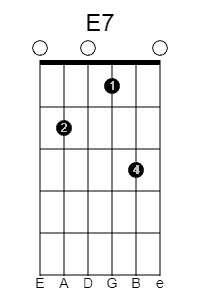

What are seventh chords good for? Well, they are great pivotal chords that can help you resolve a song’s transition toward the chorus, for example.
Let’s do a very small exercise so you can understand, and therefore unleash, the seventh chord’s true power.
Play the following chords one after the other:
D7 and G.
A7 and D.
Can you hear the relationship between these chords?
Well, you’re one step closer to training your ear musically to understand the intervals in songs.
10 Easy Songs to Practice With
You’ll find no chords you don’t know in these songs.
They’re a great way to practice what you just learned.
So, devote some time to practice them and pay special attention to chord changes that’s always the hardest part of guitar learning when you’re starting.
1. Zombie – Cranberries
Em | C | G | D |
2. Sweet Home Alabama – Lynyrd Skynyrd
D | C | G |
3. Stand by Me – Ben E. King
G | G | Em | Em |
C | D7 | G | G |
4. Learning to Fly – Tom Petty
F | C | Am | G |
5. Dead Flowers – The Rolling Stones
D | A | G |
6. Rocking in the Free World – Neil Young
Em | D | C | G | A |
7. Used to Love Her – Guns n’ Roses
D | A | G |
8. One – U2
Am | D | F | G | C |
9. Ho Hey – The Lumineers
F | C | Am | G |
10. Good Riddance (Time of your Life) – Green Day
G | C | D | Em |
The Bottom End
Although there’s a lot to learn before you can call yourself a proficient guitarist, these chords are an absolute must if you’re serious about playing.
So, take your time, and try to understand the feel of each set of chords and that will take you to a better understanding of the role each chord plays in these songs.
Above all, have fun playing and practicing; you’ll be paving your way to guitar mastery with a smile.
Happy playing!

Hello there, my name is Ramiro and I’ve been playing guitar for almost 20 years. I’m obsessed with everything gear-related and I thought it might be worth sharing it. From guitars, pedals, amps, and synths to studio gear and production tips, I hope you find what I post here useful, and I’ll try my best to keep it entertaining also.



